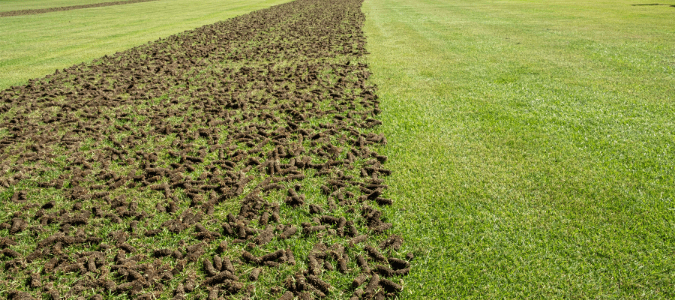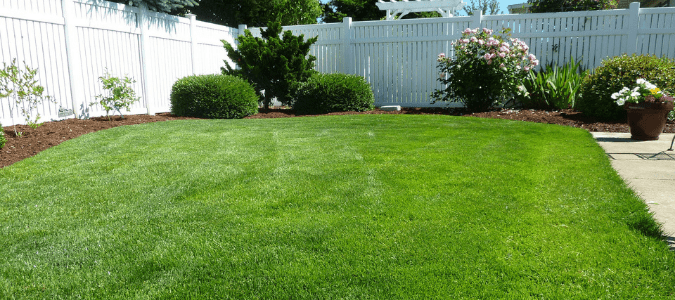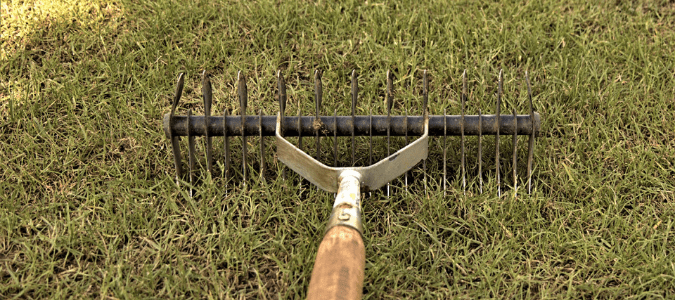Lawn care includes a list of maintenance tasks, some performed as needed, others monthly and still others every year. One of these annual jobs to get your yard in the best shape possible is aeration.
By definition, aeration is the introduction of air into a material. In this case, the material is the dirt in your lawn. Most lawns could use a good aeration regularly as long as it is done at the right time and in the right way.
Why Aerate Your Lawn?
Over time, the dirt in your yard will pack down due to people walking on it, mowers driving over it and other activities. When the dirt becomes packed down, grass roots can’t get what they need to grow. Even one-quarter of an inch of compacted dirt will block the air, nutrients and water necessary for your grass to be its healthiest.
The situation is even more of an issue if the turf gets stressed by extreme heat or drought. If you start with unhealthy grass and add in any negative conditions, you will end up with a lawn that might not come back. By poking holes in the soil, you will allow air, water and nutrients to nestle deeper into the ground and help keep the grass alive and well.
Of course, heavy machinery or vehicles driving on your lawn will definitely cause the soil to become compacted. However even something like children running around and playing normally can press the dirt down enough for grass to thin out and become weak. If the soil in your area has a high clay content, regular aeration is a necessity.
Other signs it’s time to aerate include:
- Turf was put in recently as part of new construction. Dirt under the top layer in such cases is likely compressed from the construction equipment used to build the home. The new grass might look good at first, but the soil is probably not in good enough condition to maintain that healthy-looking turf.
- Too much thatch (decomposing organic matter between soil and grass) is dehydrating the lawn. Measure the thatch area and if it’s more than a half-inch, you should aerate the entire lawn. Certain types of fast-spreading grasses such as bermuda grass are more prone to excessive thatch than other varieties. Following a bermuda grass care calendar can help ensure you’re dethatching at the right times.
- Puddling or water runoff after a good rain. Aeration will create paths for rainwater to get into the soil where it is needed instead.
You might be wondering if there is a way to measure the need for aeration. Poking a regular screwdriver into your yard’s soil can give you a good idea. If it slides in pretty easily, as it should, the soil is probably fine. If you have a harder time pushing the screwdriver in, your yard is too compacted and it will benefit from aeration.
When to Aerate
This process can’t just be performed whenever you have time. For maximum benefit, you should aerate when or just before your grass is in peak growing season. If you wait until, say, late fall, when the lawn is going dormant, the grass will have a harder time recovering. In northern climates, early spring or early fall are the ideal seasons for aeration. In the south, late spring or early summer, before temperatures soar, is when you want to perform the maintenance.
Timing is important, as is the proper balance of moisture in the soil at the time of aeration. Take the guesswork out of when to aerate, how much to aerate and how to aerate by calling a licensed lawn professional. They can evaluate the condition of your lawn and tackle the work. It can take as little as two hours to fully aerate your lawn, but if you have a large yard, you may be looking at an all-day project. Usually, it is best to let the pros handle it.
It is possible to aerate too often, so pay close attention to how healthy your lawn is looking overall. In some cases, you might need to aerate only every two to three years. Overdoing it will also damage your lawn and make it hard for grass to recover. In climates that experience extreme weather or cold and dry winters, twice-yearly aeration might be necessary.
How to Aerate
There are several ways you can tackle the job: manual tools, power tools and heavy equipment. The method you choose to aerate your lawn will depend on the size of the lawn and also your comfort level with each method. Consult with a lawn pro if you are unsure which way to go.
A popular choice is to use core or plug aerators. These use rows of tines that pull plugs of soil out of the ground and drop them on top of your grass. There, the plugs break down while the holes created by the aerator allow water, nutrients and air into the ground so it can reach the grass roots.
The process works best when done in the same manner in which you mow. Going back and forth, row by row, paying special attention to high-traffic areas such as pet runs and play areas. Go over each row from different angles to be sure you don’t miss any spots and that the proper amount of holes are in the soil to allow the grass to regain nutrients. If it’s the first time you are aerating your lawn, go over the entire space twice.
If you don’t have the tools or the time to aerate your lawn, contact a professional. A lawn care team can always tackle this job for you.
How To Prep for Aeration
Before you start the project, you will need to take a few steps. First, think about marking things like invisible fences, septic lines or underground sprinkler parts. You can do this with flags or other objects that will ensure any tool used in the maintenance doesn’t cause any damage. Then pick up all toys, chairs, hoses and other property plus debris like leaves from the lawn.
About a day before you plan to aerate or have your lawn professional do the job, mow your lawn and give it a light watering. You want the soil to be soft but don’t soak the ground. Of course, if it rains the day before, no watering is necessary.
After You Aerate
Once you or your lawn care professional have completed the aeration process, there is another set of steps to complete to ensure success. Just as you watered the lawn the day before the task, be sure to water it well after aeration. Then apply lawn food to help jump-start the nutrients’ flow to the roots of the grass.
Cover the newly aerated soil with a layer of topsoil mixed with compost. Spread the layer about a quarter-inch thick.
If your soil has a lot of clay in it, remove the plugs that settled on top of the lawn during aeration and top dress the lawn instead of following the above process. In any case, do not mow the lawn again for at least a week or until the grass has grown three inches.
How To Aerate Lawn by Hand
Some people have fairly small lawns, and those can be aerated manually if you desire to do so. No matter the size of the lawn, the manual process is still a good bit of work.
You could use spike aerators that attach to your shoes and walk all over the yard. The spikes poke holes in the soil, however the shoes can also compact soil between the spikes, making them ineffective. Find a hand aerifier with hollow tubes.
Then, push the aerifier’s tubes into the soil and pull back out. Leave the soil that pulls up into the tubes lying on the grass’ surface. Repeat the steps every four to six inches across your entire lawn. If you don’t have such a tool, use a spading fork. Push the fork into the soil about four inches deep. Rock the fork back and forth and then remove it from the soil. Repeat every four to six inches. When finished, take a rake to the soil plugs or cores you left on the lawn but don’t remove them.
To get the most out of your lawn aeration efforts, be sure to water your lawn regularly instead of waiting for rain to help out your grass, and keep kids, pets and wheels off the yard until the new grass seeds have germinated and had a chance to establish themselves.
ABC Can Ensure Your Lawn Has the Nutrients It Needs
Aeration is important for your lawn. However, it’s understandable if you don’t want to spend time working on your yard—especially if it’s a hot day! Instead of aerating your lawn yourself, contact ABC Home & Commercial Services. Our lawn care team will aerate your lawn correctly, so you don’t have to worry about when or how to aerate your lawn. We can also handle other lawn care tasks, like fertilizing your lawn.



